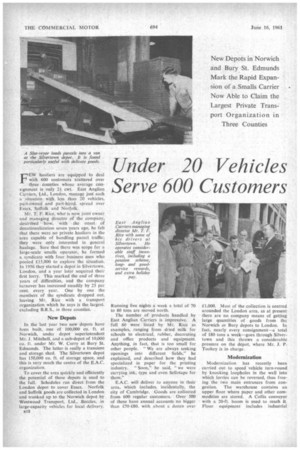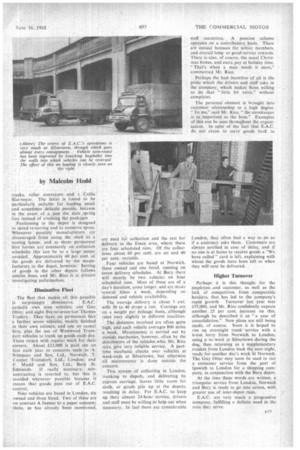Under 20 Vehicles Serve 600 Customers
Page 52

Page 53

If you've noticed an error in this article please click here to report it so we can fix it.
by Malcolm Hodd
FEW hauliers are equipped to deal with 640 customers scattered over three eounties whose average consignment is only 2+ cwt. East Anglian Carriers, Ltd., London, manage just such a situation with. less than 26 vehicles, part-owned and part-hired, spread over Essex, Suffolk and Norfolk, Mr. T. F. Rice, who is now joint owner and managing director of the company, described • 'how, with the onset of denationalization seven years ago, he felt that there were no private hauliers in the area capable of handling parcel traffic: they were only interested in general haulage. Sure that there was scope for a large-scale smalls operator, he formed a syndicate with four business men who pooled £15,000 to explore the situation. In 1956 they started a depot in Silvertown, London, and a year later acquired their first lorry. This marked the end of three years of difficulties, and the company turnover has increased steadily by 25 per cent. every year. One by one the menibers of the syndicate dropped out, leaving Mr. Rice with a transport organization which he says is the largest. excluding B.R.S., in three counties, New Depots
In the last year two new depots have been built, one of 100,000 Cu. ft. at Norwich, under depot superintendent Mr. J. Mitchell, and a sub-depot of 10,000 Cu. ft. under Mr. W. Curry at Bury St. Edmunds. The latter is really a transient and storage shed. The Silvertown depot has 150,000 cu. ft. of storage space, and this is very much the centre of the E.A.C. organization.
To cover the area quickly and efficiently the potential of these depots is used to the full. Schedules run direct from the London depot to cover Essex. Norfolk and Suffolk goods are collected in London and trunked up to the Norwich depot by Westwood Transport, Ltd., Beccles, in large-capacity vehicles for local delivery.
al8 Running five nights a week a total of 70 to 80 tons are moved north.
The number of products handled by East Anglian Carriers is impressive. A full 60 were listed by Mr. Rice as examples, ranging from dried milk for schools to electrical, rubber, decorating and office products and equipment. Anything, in fact, that is too small for other people. "We are always seeking openings into different fields," he explained, and described bow they had specialized in paper for the printing industry. "Soon," he said, "we were carrying ink, type and even Sellotape for them."
E.A.C. will deliver to anyone in their area, which includes, incidentally, the city of Cambridge. Goods are collected from 600 regular customers. Over 500 of these have annual accounts no bigger than t70-£80. with about a dozen over
£1,000. Most of the collection is centred arounded the London area, as at present there are no company means of getting large quantities of goods from the Norwich or Bury depots to London. In fact, nearly every consignment—a total of 180 tons a week—goes through Silvertown and this throws a considerable pressure on the depot, where Mr. J. P. Toohey is in charge.
Modernization
Modernization has recently been carried out to speed vehicle turn-round by knocking loopholes in the wall into which lorries can be reversed, thus freeing the two main entrances from congestion. The warehouse contains an upper floor where paper and other commodities are stored. A Collis conveyor with a 20-ft. boom is used to reach it. Floor equipment includes industrial
trucks, roller conveyors and a 'Collis Slat-veyor. The latter is found to he particularly suitable for loading' small and sometimes delicate parcels, because in the event of ,a, jam the slats .spring free instead of crushing the packages.
Positioning in the depot is designed to speed re-sorting and to conserve space.' Whenever possible.. manufacturers are discouraged from •using. thc shed as A storing house, and as -three permanent hire lorries • areconstantly on .collection schedules this can be to a large extent avoided.. Approximately 40 per cent, of the goods are delivered by the manufacturers to the depot,. however. Sorting of goods in the other depots follows similar lines, and Mr. •Rice is at Present investigating palletization:
. .
Diminutive • Fleet The fleet that makes :all this possible is surprisingly diminutive. E.A.C. actually own nine vehicles, one Guy Otter, and eight. five-to-seven-ton 'Thames Traders. They have, on permanent hire a further seven vehicles, mostly finished in their own colours; and one on casual hire, plus the use of Westwood Transport vehicles to trunk up goods each day. These return with reeular work for their owners, About £12,000 is paid Mit on hire each year to concerns suchas A. Stimpsou and Son, Ltd., Norwich; T. Cooper 'Transport. Ltd., London; and F. Mudd and Son, Ltd., Bury St.
Edmunds. If . really necessary, , subcontraction is resorted to, but this is avoided whenever possible because it means that goods pass out of E.A.C. control.
Nine vehicles are based in London, six owned and three hired. Two of these are on contract A licence to a paper concern; three, as has already been mentioned, are used fo'r collection and the rest for delivery in the Essex area, where there are fOur scheduled runs. Of the collections about 60 per cent. are set and 40 per cent. variable.
Four vehicles are based at Norwich, three owned and one hired, running on Seven delivery schedules. At Bury there will shortly be two vehicles on four scheduled runs. Most of these are of a day's duration, some longer, and are made several times a week, depending on demand and vehicle availability.
The average delivery is about 3 cwt. with 30 to 40 drops a run. Costings arc On a weight per mileage basis, although rates vary slightly in different localities.
• The distances involved are often quite high, and each vehicle averages 800 miles a week. Maintenance is carried out by Outside mechanics, however, often by the distributors of the vehicles who, Mr. Rice says, give very reliable service. A parttime mechanic checks over vehicles at week-ends at Silvertown, but otherwise all maintenance is done outside the concern.
This system of collecting in London, irunking to depots, and delivering by express carriage, leaves little room for sloth, or goods pile up at the depots, resulting in delay. For E.A.C. to. keep up their almost 24-hour service, drivers and staff must be willing to help out when necessary. In fact there are considerable staff incentives.. A pension scheme operates on a contributory basis. There are annual bonuses for senior members, and overall longor good-servicz. rewards. There is also, of course, the usual Christmas bonus, and extra pay at holiday time. "That's when a man needs it most," commented Mr. Rice.
Perhaps the best incentive of all is the pride which the drivers and staff take in the company, which makes them willing to do that "little bit extra" without complaint.
The personal element is brought into customer relationship to a high degree. "To me," said Mr. Rice, "the storekeeper is as important as the boss." Examples of this can be seen throughout the organization. In spite of the fact that E.A.C. do not claim to carry goods back to
London, they often find a way to do so if a customer asks them. Customers are always notified in case of delay, and if no one is at home to receive goods a "We have called" card is left; explaining with whom the goods have been left or when they will next be delivered.
Higher Turnover
Perhaps it is this thought for the employee and customer, as well as the lack of competition from comparable hauliers, that has led to the company's rapid growth. Turnover last year was £55,000, and Mr. Rice confidently expects another. 25 per cent. increase on this, although he described it as "a year of consolidation." New plans are still being made, of course. Soon it is hoped to run au overnight trunk *service with a 6-ton lorry from Norwich to London, using it to work at Silvertown during the da5, then returning as a supplementary trunker from London back the next night, ready for another day's work at Norwich. The Guy Otter may soon be used to run a container service from the port of Ipswich to London for a shipping company, in conjunction with the Bury depot.
At the time these words are written, a triangular service from London, Norwich and Bury is ready to go into action, with greater use of inter-depot runs.
E.A.C. are very much a progressive company, fulfilling a definite need in the area they serve.




















































































































